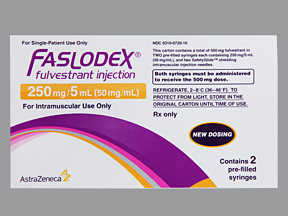FULVESTRANT - INJECTION
PHONETIC PRONUNCIATION: (ful-VES-trant)
COMMON BRAND NAME(S): Faslodex
GENERIC NAME(S): fulvestrant
Uses
USES: Fulvestrant is used to treat certain types of breast cancer. Breast cancer cells need the hormone estrogen in order to grow. Fulvestrant works by blocking the effect of estrogen, slowing tumor cell growth.
How to use FULVESTRANT - INJECTION
HOW TO USE: Read the Patient Information Leaflet if available from your pharmacist before you start using fulvestrant and each time you get a refill. If you have any questions, ask your doctor or pharmacist. This medication is given by slow injection into the buttock muscle by a health care professional. It is given as directed by your doctor, usually every 2 weeks for the first 3 doses and then monthly. The dosage is based on your medical condition.
Side Effects
Precautions
Interactions
Overdose
Images
Reviews
Faq for FULVESTRANT - INJECTION
Fulvestrant injection is used to treat hormone receptor-positive (HR+), human epidermal growth factor receptor 2-negative (HER2-) advanced breast cancer in postmenopausal women who have not previously received endocrine therapy or have disease progression following endocrine therapy.
Fulvestrant injection works by blocking the action of estrogen on breast cancer cells. It binds to the estrogen receptors, causing a downregulation and degradation of the receptors, leading to a decrease in estrogen signaling and inhibition of tumor growth.
Fulvestrant injection is given as an intramuscular injection into the buttocks. It is usually given as two separate 5 mL injections (each containing 250 mg) on days 1, 15, and 29, and then once monthly thereafter.
Common side effects of fulvestrant injection include injection site reactions (pain, swelling, itching), hot flashes, headache, nausea, bone pain, joint pain, fatigue, and constipation. Your healthcare provider will monitor for any serious side effects.
Fulvestrant injection may cause a decrease in bone mineral density, so it is important to monitor bone health and consider calcium and vitamin D supplementation. It may also cause fetal harm, so it should not be used during pregnancy. It is important to use effective contraception during treatment.
Fulvestrant injection is only approved for use in postmenopausal women with HR+, HER2- advanced breast cancer. Its safety and effectiveness in men have not been established.
If you miss a dose, contact your healthcare provider to schedule the missed dose as soon as possible. Do not double the dose to make up for a missed one.
The duration of treatment with fulvestrant injection will depend on your individual response to the medication. Your healthcare provider will monitor your progress and determine the appropriate duration of treatment.
Fulvestrant injection can be used as standalone treatment or in combination with other drugs, such as targeted therapies or chemotherapy, depending on the specific situation and recommendations from your healthcare provider.
Fulvestrant is an injection used in the treatment of breast cancer. It belongs to a class of medications called selective estrogen receptor degraders (SERDs) that work by blocking the action of estrogen in the body.
Fulvestrant is given as an intramuscular injection into the buttocks. The injection should be administered once a month by a healthcare professional.
Common side effects of Fulvestrant may include hot flashes, nausea, fatigue, headache, joint pain, and injection site reactions such as pain, swelling, or bruising.
Fulvestrant has been shown to be effective in treating various types of breast cancer, especially in postmenopausal women with hormone receptor-positive metastatic breast cancer who have not responded well to other treatments.
Yes, Fulvestrant can be used in combination with other breast cancer medications, such as aromatase inhibitors or CDK4/6 inhibitors, to provide a more comprehensive treatment approach.
The duration of Fulvestrant treatment may vary depending on the individual's response to the medication and the stage of breast cancer being treated. It may be given for several months or even years.
Fulvestrant should not be used in individuals with a known hypersensitivity to the medication. It should also be used with caution in patients with liver or kidney problems, as well as in pregnant or breastfeeding women.
Fulvestrant should be stored in the refrigerator between 36°F to 46°F (2°C to 8°C). It should not be frozen. Once the medication is removed from the refrigerator, it should be used within 30 minutes.
No, Fulvestrant should be administered by a healthcare professional. It is not recommended for self-administration at home.
Disclaimer
IMPORTANT: HOW TO USE THIS INFORMATION: This is a summary and does NOT have all possible information about this product. This information does not assure that this product is safe, effective, or appropriate for you. This information is not individual medical advice and does not substitute for the advice of your health care professional. Always ask your health care professional for complete information about this product and your specific health needs.

No Reviews Yet